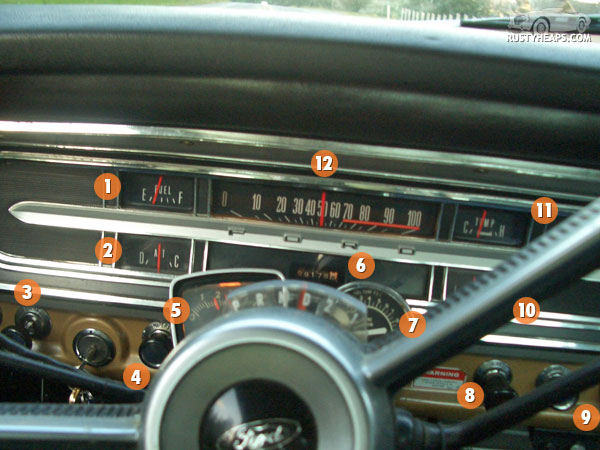It is wise to become familiar with the controls and dash of your F250 before taking to the road. You may wish to refer to the illustration while reading the reference below.
- Fuel Gauge: This needle will move constantly from right to left, much like the second hand on a watch–this is normal. The reading you see here is typical. There is a lever under your seat to switch from the main 16 gallon tank to the auxiliary 20 gallon tank, and then to the auxiliary auxiliary 10 gallon backup. This three-tank sequence will typically enable you to reach a gas station if one is within a reasonable distance.1
- Ampere or “Alternator” Indicator: You can safely ignore this instrument as the needle will only move if you’re struck by lightning, and even then only if the bolt earths itself via this instrument.2
- Light Switch: Pull on, push off. Even a Ford owner can understand this.3
- Wiper Switch: For your convenience, we have included an intermittent feature–by turning the switch on and off by hand, you can infinitely vary the interval at which the wipers clear the screen.4
- After-Market Tachometer: Included is a manually set needle for red-line which, as far as an owner of typical intelligence can surmise, cannot be reset. It is currently set to a 1920-esque 2200 RPM.5
- Odometer: From the good old days when a car reaching six-digit miles was almost unthinkable.6
- After-Market Vacuum Gauge: Your F250 will barely squeak into the “economy driving range” if you coast; any whiff of the gas pedal will take you into the “Performance Range,” which is to say your fuel use is measured in gallons per minute.7
- Cargo Light Switch: Useful for loading rusty junk into the bed at night. Lights up when activated, too, which will tempt you to leave it on as you drive down the road.8
- Cigarette Lighter: Doctors suggest smoking a pack a day to steady your nerves.9
- Oil Pressure Gauge (hidden): Do not be too surprised if your Ford Big Block V8 registers barely any reading at all on this, even at highways speeds.10
- Coolant Temperature Gauge: F250s come with two varieties of engine: the first variety barely causes this gauge to read into the “normal” range, as seen here, even on a scorching day. The other variety immediately has this gauge heading for “H” on start-up, even in an Alaskan winter, and hovers a needle’s width below “H” all of the time. Owners of trucks in the first group have less than half the stress-induced heart problems as owners of trucks in the second group.11
- Speedometer: No weaselly mark at 55, just a lot of red after 70, which is a reminder to keep an eye on the fuel gauge as it will be moving fairly quickly itself at those speeds.12
1 Reasonable = 20 miles, less if there is a hill.
2 Really, has anyone ever seen the amp gauge on an old American car or truck move, at all?
3 The functionality of this switch has never been improved–the label says “Lights” and if you pull on it, the lights come on.
4 Do not accept electronic substitutes!
5 Really. But I’m also quite dim.
6 Goldie just turned 100,000 a couple of months ago, as a matter-of-fact.
7 This is one of the least useful–but liveliest–of instruments. Though it is more useful than the altimeter in my MGB.
8 Works, too!
9 I just plug my cell into this, not needing my nerves steadied.
10 Goldie has decent pressure, but a lot of old Ford trucks have gauges which barely move from “0”.
11 Goldie is in the “runs cool” club, the red ’69 was in the other.
12 Shown is the speed Whidbey Islanders travel on any highway. Oh, yeah, it gets old.

LOL!!
I’ll be sure and print this out in case I have to drive it! :)
Very nice. I’ve got a 64 and this sounds about the same.
this is pretty good considering i’m gettin one of these too thanks for the info
Top stuff! Great idea for a blog post.